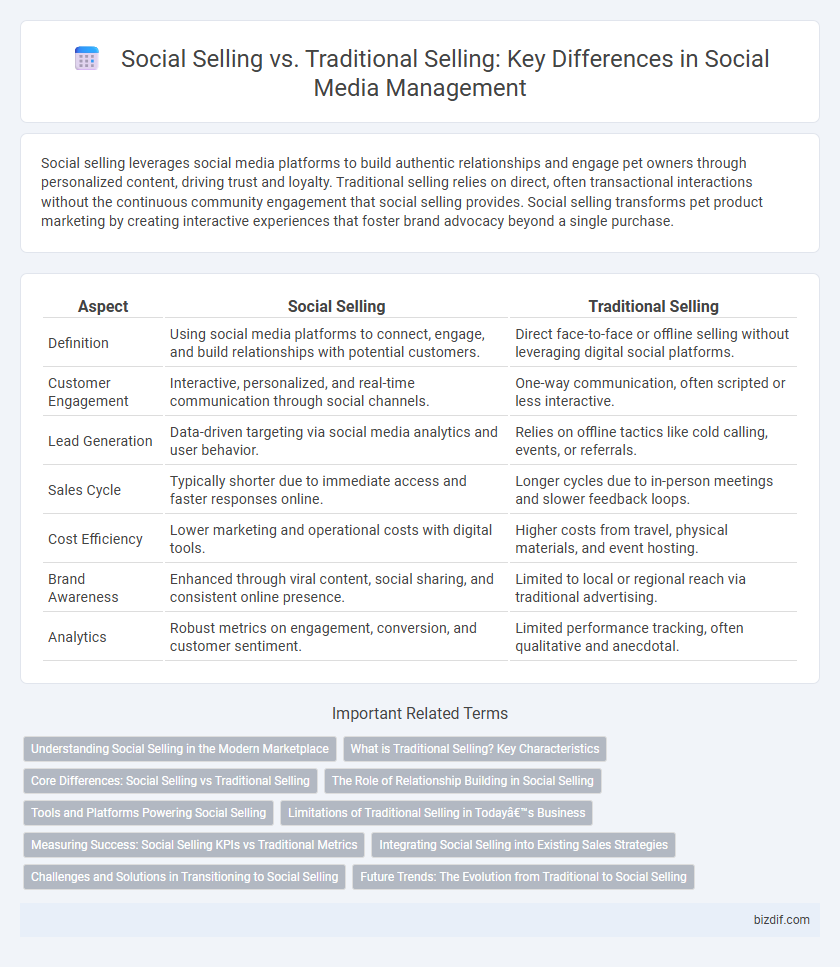Social selling leverages social media platforms to build authentic relationships and engage pet owners through personalized content, driving trust and loyalty. Traditional selling relies on direct, often transactional interactions without the continuous community engagement that social selling provides. Social selling transforms pet product marketing by creating interactive experiences that foster brand advocacy beyond a single purchase.
Table of Comparison
| Aspect | Social Selling | Traditional Selling |
|---|---|---|
| Definition | Using social media platforms to connect, engage, and build relationships with potential customers. | Direct face-to-face or offline selling without leveraging digital social platforms. |
| Customer Engagement | Interactive, personalized, and real-time communication through social channels. | One-way communication, often scripted or less interactive. |
| Lead Generation | Data-driven targeting via social media analytics and user behavior. | Relies on offline tactics like cold calling, events, or referrals. |
| Sales Cycle | Typically shorter due to immediate access and faster responses online. | Longer cycles due to in-person meetings and slower feedback loops. |
| Cost Efficiency | Lower marketing and operational costs with digital tools. | Higher costs from travel, physical materials, and event hosting. |
| Brand Awareness | Enhanced through viral content, social sharing, and consistent online presence. | Limited to local or regional reach via traditional advertising. |
| Analytics | Robust metrics on engagement, conversion, and customer sentiment. | Limited performance tracking, often qualitative and anecdotal. |
Understanding Social Selling in the Modern Marketplace
Social selling leverages social media platforms to build authentic relationships and engage potential customers through personalized content and interactions, differing from traditional selling's reliance on direct outreach and transactional methods. Modern consumers increasingly trust peer recommendations and online reviews, making social selling crucial for brand credibility and lead nurturing. Integrating social selling into business strategies enhances customer insights, accelerates the sales cycle, and drives higher conversion rates in the digital marketplace.
What is Traditional Selling? Key Characteristics
Traditional selling involves direct interaction between sales representatives and customers, often through face-to-face meetings, phone calls, or in-store visits. Key characteristics include a focus on transactional relationships, reliance on personal rapport, and limited use of digital tools or platforms. This method emphasizes product features and benefits, with sales cycles typically being longer and less data-driven compared to social selling.
Core Differences: Social Selling vs Traditional Selling
Social selling leverages social media platforms to build relationships, engage prospects, and influence purchasing decisions through personalized content and interactions. Traditional selling relies on direct, face-to-face communication, cold calls, and in-person meetings to drive sales. Social selling emphasizes trust and long-term engagement, while traditional selling focuses on transactional and immediate outcomes.
The Role of Relationship Building in Social Selling
Social selling leverages relationship building through personalized interactions on platforms such as LinkedIn and Instagram, enhancing trust and brand loyalty more effectively than traditional selling methods. Unlike conventional sales that rely on cold calls or face-to-face meetings, social selling utilizes data-driven insights and consistent engagement to nurture prospects over time. Building authentic relationships via social media leads to higher conversion rates and long-term customer retention, critical components for modern sales success.
Tools and Platforms Powering Social Selling
Social selling leverages advanced tools like LinkedIn Sales Navigator, Hootsuite, and HubSpot CRM to identify prospects, engage leads, and track interactions in real-time, streamlining the sales process. Platforms such as Instagram, Facebook, and TikTok enable personalized brand storytelling and direct customer interactions, enhancing trust and conversion rates. Traditional selling relies on face-to-face meetings and cold calling, which lack the scalability and data-driven insights offered by modern social selling technologies.
Limitations of Traditional Selling in Today’s Business
Traditional selling faces limitations in today's business environment due to its reliance on face-to-face interactions and limited reach, which restricts access to a broader, digitally connected audience. It often lacks real-time engagement and personalized communication, making it harder to build trust and respond promptly to customer needs. This approach struggles with data-driven insights, reducing its effectiveness in targeting and nurturing potential buyers compared to social selling techniques.
Measuring Success: Social Selling KPIs vs Traditional Metrics
Social selling KPIs such as engagement rate, click-through rate, and social share of voice provide real-time insights into customer interactions and brand influence across digital platforms. Traditional selling metrics like sales volume, conversion rate, and customer acquisition cost focus primarily on direct sales outcomes and financial performance. Measuring success in social media management requires balancing these dynamic social selling indicators with conventional sales metrics to optimize overall sales strategy and ROI.
Integrating Social Selling into Existing Sales Strategies
Integrating social selling into existing sales strategies enhances customer engagement by leveraging social media platforms like LinkedIn and Instagram for personalized interactions and real-time feedback. This approach increases lead generation and conversion rates by targeting prospects with tailored content based on data analytics and buyer behavior. Companies combining social selling techniques with traditional sales methods report improved brand credibility and stronger long-term customer relationships.
Challenges and Solutions in Transitioning to Social Selling
Transitioning to social selling presents challenges such as building authentic customer relationships through digital channels, managing continuous content creation, and navigating platform algorithms. Solutions include leveraging data analytics to tailor social media strategies, investing in social CRM tools for personalized engagement, and training sales teams in social media communication skills. Emphasizing a customer-centric approach enhances trust and boosts conversion rates in the evolving digital sales landscape.
Future Trends: The Evolution from Traditional to Social Selling
Future trends in social selling emphasize leveraging data analytics, AI-driven customer insights, and personalized engagement to outperform traditional selling methods. Social selling integrates real-time interactions on platforms like LinkedIn and Instagram, facilitating seamless buyer journeys and higher conversion rates. Businesses adopting these digital strategies experience enhanced brand loyalty and competitive advantage in the evolving marketplace.
Social selling vs traditional selling Infographic

 bizdif.com
bizdif.com